McGuinn.html

Founder of the Byrds
Jim
McGuinn, later known as Roger, was already a veteran of the New York
and Los Angeles music scene when he co-founded the group that would
become the Byrds with Gene Clark and David Crosby in 1964.
Video
12-string
instructional video
Tour
Tour
schedule
Folk Den
Folk
Den
|
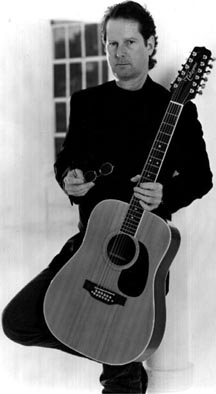 Roger
McGuinn, prior to forming the Byrds, toured and performed
folk musicwith the
Limeliters, Chad Mitchell Trio and
Bobby Darin
as a guitarist and banjo player. Roger
McGuinn, prior to forming the Byrds, toured and performed
folk musicwith the
Limeliters, Chad Mitchell Trio and
Bobby Darin
as a guitarist and banjo player.
McGuinn, a Chicago native, studied at the Old Town School of Folk
Music and was active on Chicago's folk scene, where he was
strongly influenced as a teenager by
Bob Gibson.
Within a few weeks of finishing high school, McGuinn was working
with the Limeliters in California, and he played guitar and banjo
on their album "Tonight: In Person."
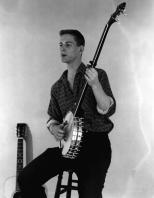
McGuinn is also on the Chad Mitchell Trio's album "Mighty Day on
Campus",1961.
After touring for awhile with singer
Bobby Darin,
McGuinn moved to New York at Darin's request to work for his
publishing company, TM Music,
in the the fabled Brill Building as a songwriter. He and
Frank Gari co wrote the song "Beach Ball,"and performed it with
Darin, as the City Surfers, on a very rare single, July 1963.
After hearing the Beatles for the first time at the Brill
Building, Roger began playing folk songs to a rock beat in the
coffee houses of Greenwich Village .
His experiments in merging folk and rock didn't please the folk
purist, so he moved to Los Angeles to work at the Troubadour. It
was after an opening set for Hoyt Axton that Gene Clark approached
Roger with appreciation for his new musical blend.They started
writing songs together in the folk den of the Troubadour.
It wasn't long before David Crosby joined them and added his
unique concepts of harmony to the duo, thereby completing the
underpinnings for one of the most influential bands of the '60s.
|
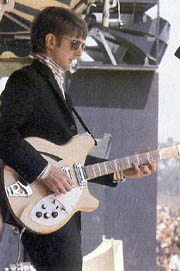
Within
a few months, McGuinn, Clark & Crosby were looking to expand their
group. Conga player Michael Clarke was recruited because he looked like
two of the Rolling Stones. Mandolin player Chris Hillman was asked to join
the group and learn to play the bass guitar. During a Thanksgiving dinner
the band settled on the name "Byrds," and success was just around the
corner.
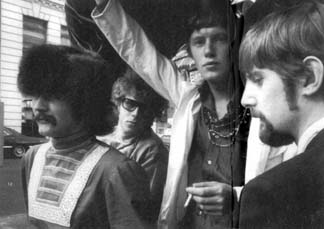 Columbia
Records signed the Byrds in January 1965 and they recorded their first
number one hit, "Mr. Tambourine Man."
Columbia
Records signed the Byrds in January 1965 and they recorded their first
number one hit, "Mr. Tambourine Man."
In
1968 McGuinn and Hillman hired Gram Parsons and headed for Nashville where
they recorded the now critically acclaimed "Sweetheart of the Rodeo."
Roger
McGuinn disbanded the Byrds in 1973 to pursue his dream of a solo career.
He made five solo albums on Columbia Records. .
McGuinn
rejoined Gene Clark and Chris Hillman in 1978 on Capitol
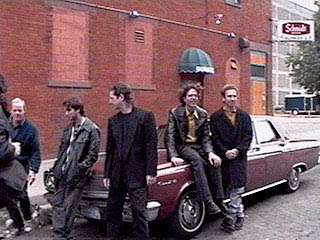 Records
for three albums.
Records
for three albums.
In
1981 Roger decided it was time to return to his folk roots and began
touring solo acoustic.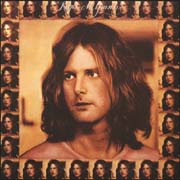
Arista
records released "Back From Rio" in 1991, a rock album that included his
friends, Tom Petty and The Heartbreakers, Elvis Costello, Chris Hillman,
David Crosby, Michael Penn and John Jorgensen. After touring extensively
to support the album he returned to his roots - folk music.
In
November 1995, McGuinn began recording and uploading to the Internet a
series of traditional folk songs to his web site. The recordings are
available for free download at the "Folk Den
- http://folkden.com," part of McGuinn's
home page - http://mcguinn.com.
The
autobiographical one man show, "Live
from Mars," was released on Hollywood Records in November of 1996.
The album includes two studio tracks, "May The Road Rise To Meet You," and
"Fireworks," recorded in Minneapolis with members of the Jayhawks.
Roger's
CD recorded on Appleseed Recordings, titled "Treasures From The Folk Den."
A CD of favorite songs from the Folk Den with the added bonus of duets
with Pete Seeger, Joan Baez, Judy Collins, Odetta, Jean Ritchie, Josh
White Jr. and Frank and Mary Hamilton. It was nominated for a Grammy in
2002 in the category of "Best Traditional Folk Album."
An
Evening with Roger McGuinn begins with the stage dark and the sound of
Roger’s 12-string Rickenbacker guitar filling the house as he approaches
the standing microphone to sing his signature Bob Dylan song “My Back
Pages.” He always begins his concerts with this song because he takes the
audience on the journey through which his love of folk music took him to
the Rock and Roll Hall of Fame.
Jim
McGuinn (he changed his name later to Roger) began playing guitar when he
was 14 and left Chicago for his first professional job at 17. The
Limeliters sent him an airplane ticket to Los Angeles to play guitar and
banjo on their RCA album “Tonight in Person.” It was during that recording
time that he joined them at the Hollywood Bowl opening up for Eartha Kit.”
Chad
Mitchell heard about McGuinn's abilities and asked him to join his group,
“The Chad Mitchell Trio” as the accompanist on guitar and banjo. He was 18
years old.
He
toured with the CMT for a year or so but when Bobby Darin saw him
performing, he immediately offered McGuinn a job paying twice what he was
making with Mitchell. Mr. Darin asked Jim to play his guitar and sing a 15
minute set of folk songs in the middle of his variety concert.
When
Bobby decided to take a break from performing live, he invited Jim to join
him in New York city to work at the famed Brill Building as a songwriter
for TM Music. It was a day job, so in the evenings Jim would work as a
studio musician in the City. He became Judy Collins' musical director,
helped Paul Simon record the demo for "Sound of Silence" and was very
active in the recording business as the “go to” guy for 12-string guitar.
It
was at the Brill Building that Jim first heard the most fascinating music
come over the radio. The Beatles were using folk music chords with a rock
beat. He was drawn to the idea and began singing 'rocked up' folk
music in Greenwich Village coffee houses. The performances did not endear
him to the folk singers of the time, but the club owner loved it. He put a
sign outside advertising "Beatle Impersonations" ... which McGuinn
found embarrassing. He needed to get out of New York; so he accepted a job
in Los Angeles at the Troubadour folk club, opening up for Hoyt Axton.
Hoyt
Axton was the first person to invite Jim to sing on a recording. He sang
harmony on Hoyt's "Balladeer" album.
The
folk audience didn’t appreciate the combination of folk songs and a Beatle
Beat anymore than the folkies in Greenwich village but there was one
musician that did. His name was Gene Clark. It was the beginning of a
musical revolution.
David
Crosby, Chris Hillman and Michael Clarke joined the duo and history was
about to be made. The Byrds were born!
Their
first single was penned by Bob Dylan but when the group heard the demo,
they weren’t too impressed. Jim had an idea on how to fix the folkie song.
He had been an arranger in NYC, so adding a Bach type intro and a Beatle
Beat took the song “Mr Tambourine Man” to the number one slot across the
world.
Roger
(he had changed his name) disbanded the BYRDS in 1973 to pursue his dream
of being a folk singer like Pete Seeger. He says that the BYRDS were a
nice detour on his way to his dream.
He
recorded five solo albums on Columbia Records. In 1978 he joined with Gene
Clark and Chris Hillman for 3 albums on Capitol Records. In 1991 just
after the BYRDS were inducted to the Rock and Roll Hall of Fame, he
recorded on Arista Records his acclaimed “Back From Rio” album with a host
of friends, including Tom Petty, Elvis Costello , David Crosby, Chris
Hillman and others. It was the last vinyl record in his catalogue.
In
1995 Roger became concerned the traditional folk songs were being lost. No
one was recording the songs of over one hundred years ago, so he had an
idea. He had always been interested in technology and the world wide web
was coming of age. He decided to post an original folk song with a live
recording on his web page mcguinn.com each
month. He hasn’t missed a month since November 1995. It is carried by the
University of North Carolina at Chapel Hill as a public service.
In
1996 he released his autobiographical one man show on Hollywood Records,
“Live From Mars.” The Jayhawks joined him for two studio recordings, “May
The Road Rise To Meet You” and “Fireworks.”
Appleseed
Records invited Roger to record some of his favorite folk songs with the
vanguards of folk music: Pete Seeger, Joan Baez, Judy Collins, Jean
Ritche, Josh White Jr and his guitar teacher Frank Hamilton and his wife
Mary. The recording “Treasure From the Folk Den” received a Grammy
nomination in 2002.
In
2005, Roger went into the studio with John Jorgensen and Stan Lynch to
record a tribute to his late friend George Harrison, ‘If I Needed
Someone.” It was fitting for Roger to record it because George told him
that he was inspired by Roger’s guitar work on “Bells Of Rhymney.” This
recording became the beginning for Roger's own recording label, “April
First Productions.” The name was from the wedding date in 1978 to Camilla.
He released another 4-CD set to commemorate the 20 year Folk Den
Anniversary in 2015.
With
freedom that came with his own label Roger could record anything he wanted
and he did.
CCD,
a recording of sea shanties was one of his favorites because of the lore
of the sea. He also released a live concert recorded for his mother’s 102
birthday which includes a DVD with some concert footage and friends
talking about his influence including Tom Petty, Bruce Springsteen, Joan
Baez, Judy Collins, Chris Hillman, Dave Barry, Pete Seeger and Derek
Taylor.
The
fans at concerts wanted recordings of some BYRDS songs, so Roger
re-recorded “Mr. Tambourine Man, ”So You Want to Be a Rock and Roll Star”
and “Turn Turn Turn.” Since Roger was the lead singer and lead guitar
player on those songs in the BYRDS, the songs sound like the BYRDS. He
included new songs on this CD called “Sweet Memories.”
During
the year at home through the COVID lock down, Roger and Camilla decided to
send a Christmas CD to friends as a Christmas card. The friends encouraged
then to release it to the public since it is a true Christmas CD...simply
titled “Merry Christmas”
When
asked if he plans on retiring, he laughs, “What? Give up show-business?
It’s called “playing music" and I’ve been playing since I was 14.

More CDs









Article copyright 1996 by Richard E. Russel. Excerpt from
"Mr. Tambourine Man" performed and copyright by Roger McGuinn; used by
permission. Byrds 1967 photo reprinted from "Younger than Yesterday" CD
insert. Recent McGuinn photo, at top, courtesy of Roger McGuinn. Photo
of a young McGuinn by Jim Marshall. McGuinn Clark & Hillman and
Crosby McGuinn & Hillman photos by Henry Diltz from the Under the
Covers CD-ROM (used by permission). Roger McGuinn and Jayhawks photo
courtesy of Roger McGuinn. Special thanks to Laura Theobald for the
photo of Chris Hillman and Roger McGuinn from Live Oak, Florida,
3/28/98. Sources of other photos unknown. Material may not be reprinted
without permission.
 Roger
McGuinn, prior to forming the Byrds, toured and performed
folk musicwith the
Limeliters, Chad Mitchell Trio and
Bobby Darin
as a guitarist and banjo player.
Roger
McGuinn, prior to forming the Byrds, toured and performed
folk musicwith the
Limeliters, Chad Mitchell Trio and
Bobby Darin
as a guitarist and banjo player.


 Columbia
Records signed the Byrds in January 1965 and they recorded their first
number one hit, "Mr. Tambourine Man."
Columbia
Records signed the Byrds in January 1965 and they recorded their first
number one hit, "Mr. Tambourine Man." Records
for three albums.
Records
for three albums.